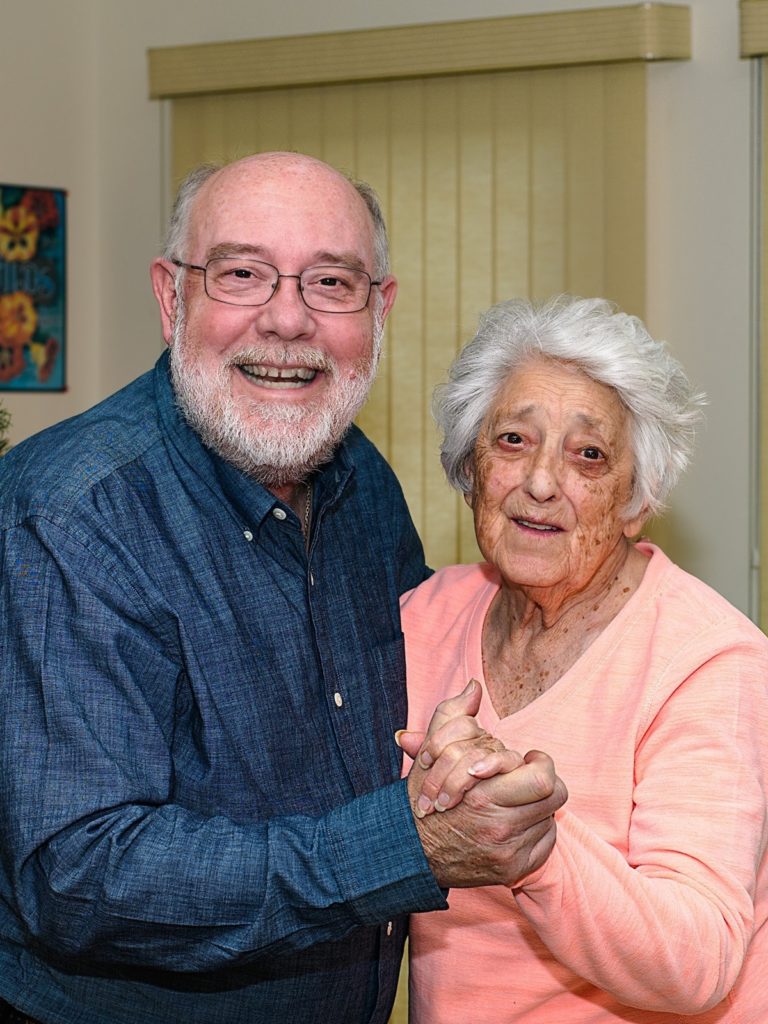
We all want the freedom to make choices. This applies to residential care as much as it does to anything else. Having no viable options to choose from can be stressful. Having too many options can be equally tricky (Schwartz, 2004). But having options is only half the story. Having appropriate information to choose between those options is just as crucial. Making a choice with no information is obviously a non-starter. However, making a choice when faced with a large amount of information on each option also creates difficulties as we struggle to process it all (Simon, 1982). The ‘right’ amount of information is whatever people feel comfortable with. It’s different for different people and different decisions but lies somewhere on a spectrum from having none to having too much information.
My own experience of undertaking research about choosing care, and involvement with family and friends going through this process, is that it can be an isolating experience (Baxter, Heavey and Birks, 2017). People often don’t know where to start in their thinking about social care and support. It’s usually a one-off experience so people can’t fall back on what they did last time. Even if a friend or family member has been through the process before, it could be some time ago and what’s right for one person may not be right for another.
The paper I discuss in this blog by Trigg and colleagues (2018), explores the type and quantity of information that makes people feel comfortable in choosing a residential care home. When I started reading this paper, I thought it was about if and how older people choosing a care home use ‘hard’ evidence on the quality of care, like national statistics or data from regulatory bodies. In fact, the paper is broader than this. It looks at the whole range of information people use to judge quality when selecting a care home for themselves or a family member, and what helps or hinders its use.
This broad perspective is helpful. And what makes this paper a bit different is that it compares data across three countries with quite different care systems and different emphases on providing people with that information.

Study looks at the whole range of information people use to judge quality when selecting a care home for themselves or a family member.
Methods
The study took place in England, the Netherlands and Spain. The study team collected data through semi-structured interviews with professionals and new care home residents and their relatives, and group workshops with relatives of people living in a care home and older people with ‘existing knowledge of long-term care services’. In practice, this meant they were drawn from current users of day care services in England and Spain, and people on waiting lists for care homes in the Netherlands.
The group workshops comprised three exercises: (1) an open discussion on the attributes of a ‘good’ care home; (2) ranking of 15 quality indicators; and (3) selection of a care home from three fictional homes each with different scores on the 15 quality indicators, with no clear leader. The 15 quality indicators were defined prior to the workshops; 13 were adapted from existing USA and European indicators and two were developed by the research team.
Interview and workshop data were analysed qualitatively using the Framework method (Ritchie and Spencer, 1994). Framework analysis was developed specifically for applied policy research. In essence, it involves writing summaries of data (typically interview transcripts) and placing these in tables called charts. Each chart focusses on a specific topic of interest, with each row of a chart representing an interviewee and each column a key issue within the wider chart topic. This layout enables understanding of the overall picture of the findings, which in turn helps researchers to describe and interpret what’s happening in the setting of interest.
Results
Trigg and colleagues present detailed findings on the availability and use of information about quality, what helped or hindered the use of this information and the type of information on quality that older people prefer. A few highlights are that:
- Catalonia does not provide any publicly available information on quality but care professionals make recommendations. England and the Netherlands provide quality information online and on paper. There is a dedicated ‘Choose Better’ website in the Netherlands. Neither Dutch nor English professionals are allowed to recommend specific providers.
- In England and the Netherlands formal information on quality is rarely used, with people preferring to focus on ‘soft’ information such as the atmosphere in the home, privacy or social activities. People tend to assume that because they are accessing care homes contracted by local councils or their care insurer, quality of care is not an issue.
- Issues that help or hinder the use of information on quality include previous knowledge and experience of care homes and time pressures.
- Findings from the workshop ranking exercises showed that people in all three countries preferred subjective to hard information. The location of the care home was especially important. Poorly understood or low priority indicators were building design and formal quality of care measures such as overuse of anti-psychotic drugs.
- Selection of one of the three fictional care homes with different quality indicators proved too difficult, in part because people felt 15 indicators was too many to take on board.

When choosing a care home, formal information on quality is rarely used, with people preferring to focus on ‘soft’ information such as the atmosphere in the home, privacy or social activities.
Conclusions
The authors conclude that the experiences of older people and their families in making decisions about care homes are remarkably similar in the three countries, with provider location and availability of places being key factors. Even where there was available information on quality, factors such as limited time and availability of places meant it could not be used to best effect. Thus choice was felt to be in effect illusory and so information on quality lacked relevance.

Even where there was available information on quality, factors such as limited time and availability of places meant it could not be used to best effect.
Strengths and limitations
A strength of this study is that it is comparative. It used the same data collection tools in each country. This made it possible for the authors to compare findings across the three countries despite quite different contexts.
A difficulty I had in reading this paper is that ‘quality information’ is never defined. The title suggests the paper is about information and choice; the abstract reads, to me, that it is ‘hard’, formal quality information that is of interest; yet the main text of the paper takes a wider perspective including hard and soft data. I’m pleased it did; it made it a more useful paper than a focus on hard data alone.
The methods seem appropriate but there is limited description of analysis, so I found it hard to decide whether using the Framework Approach to bring together and analyse the interview and workshop data was appropriate. I wasn’t clear how the ranking exercise fitted with this method.
Furthermore, the authors acknowledge that people can only process around seven pieces of information at once (Miller, 1956). It’s no surprise therefore that people found it too difficult to rank three fictional care homes based on 15 indicators. Perhaps the authors were testing to see whether people would fall back on a few vital indicators that trumped all else. This is exactly what they did – location and availability were key.

When choosing a care home, location and availability trump other factors.
Implications for practice
The findings from this paper suggest that official quality ratings such as those provided by the Care Quality Commission in England and on the Choose Better website in the Netherlands are not being used to their full potential by older people and their families. That’s not to say that people are not making good choices or that they are not comfortable with them; we cannot tell that from this study.
So what are the implications of this? On the one hand, we could do something to encourage people to use these indicators if we think it would result in ‘better’ choices – whatever that means. Supporting people to identify and understand these indicators, or for professionals to make recommendations based on them, as in Catalonia, would be an option. On the other hand, we could just accept that people prioritise softer indicators, and focus on what information people prefer, ensuring that that information is as accurate and available as possible.
Perhaps quality ratings are most useful to local council commissioners who, in England at least, are responsible for monitoring and shaping the care market. If commissioners focus on ensuring the safety and efficiency of care homes, potential residents and their families can focus on other factors that make the home feel like home.

If commissioners focus on ensuring the safety and efficiency of care homes, potential residents and their families can focus on other factors that make the home feel like home.
Links
Primary Paper
Trigg L, Kumpunen S, Holder J, Maarse H, Juvés MS, Gil J (2018). Information and choice of residential care provider for older people: a comparative study in England, the Netherlands and Spain. Ageing & Society. 2018 Jun;38(6):1121-47. [Abstract]
Other References
Baxter K, Heavey E & Birks Y (2017). Older self-funders and their information needs (PDF). London: NIHR School for Social Care Research.
Miller GA (1956). The magical number 7, plus or minus 2 – some limits on our capacity for processing information (PDF). Psychological Review, 63, 2, 81-97.
Ritchie J & Spencer L (1994). Qualitative data analysis for applied policy research by Jane Ritchie and Liz Spencer in A.Bryman and R. G. Burgess [eds.] “Analyzing qualitative data”, 1994, pp.173-194.
Schwart B (2004). The paradox of choice. Why more is less. New York: HarperCollins.
Simon HA (1982). Models of bounded rationality. Cambridge, MA: MIT Press.
Photo credits
- Feature Image cropped: https://pixabay.com/en/feedback-survey-nps-satisfaction-3709752/
- Photo by Christian Stahl on Unsplash
- Cropped photo by Ravi Kohli on Unsplash
- https://www.freepik.com/free-photo/decorative-alarm-clock-with-blue-background_1076745.htm
- Photo by Sylwia Bartyzel on Unsplash
- https://pixabay.com/en/house-at-home-fabric-decoration-1247150/
